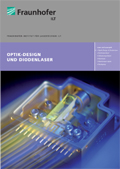
At the Fraunhofer Institute for Laser Technology ILT, we support our customers from industry and research to accomplish their tasks and answer their questions regarding optics design and the development of diode lasers. We will help you implement product strategies or plan new products by competently consulting you as well as performing market and freasibility studies. Our R&D services range from design and simulation to experimental investigations on prototypes, all the way the development of industry-oriented, CE-certified prototypes.
 Fraunhofer Institute for Laser Technology ILT
Fraunhofer Institute for Laser Technology ILT